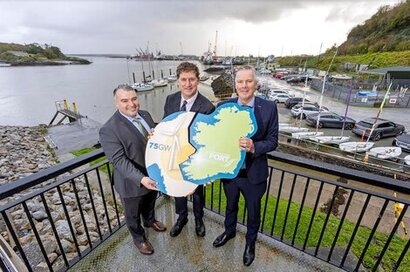
The Shannon Estuary presents a unique opportunity and is best placed in Ireland and Europe to develop the Atlantic floating offshore wind industry and help the country reach its climate goals, according to the report, which was launched by Minister for the Environment, Climate and Communications Eamon Ryan, TD.
The report found that development of the Shannon Foynes Port would play a vital role in helping Ireland meet its net zero obligations by 2050. It would also contribute significantly to Europe’s efforts, through its REPowerEU plan, to unwind its dependence on Russian fossil fuel imports and accelerate the expansion of renewables.
The potential electricity generation from the enormous renewable energy resource of the west coast winds can, the report estimates, deliver 30 gigawatts of floating offshore wind by 2050 - six times more than existing domestic demand. Significantly, this energy would also kick start a new industrial ecosystem based on the production of carbon free green electricity, hydrogen and derivatives, which will be transformational for Ireland by way of use for domestic electricity and e-fuels, electricity exports, and e-fuels exports.
At peak, up to 120 floating turbines would be installed offshore per year. The economic impacts would also be far reaching with thousands of jobs created and billions of euros invested in supply chain and route-to-market infrastructure and facilities around the region.
The report is structured around three main drivers for future growth and expansion:
Delivering floating offshore wind at scale
Green industrial development and transition – facilitating alternative fuels (‘e-fuels’) production
Expanded, diversified and more sustainable logistics services
The report identifies the numerous advantages of the Shannon Estuary, including its 500 square kilometres of deep water, its 1,400 hectares of zoned Strategic Development Locations and, particularly, its proximity to the Atlantic’s abundant offshore wind resources.
It recommends the establishment of four core facilities on the Shannon Estuary to support the delivery of floating offshore wind at scale. These are:
Turbine integration and pre-commissioning at Foynes Deepwater Port
Substructure assembly at Moneypoint
Wet storage at various locations within the Estuary
Operations & Maintenance base at the Port of Foynes.
It found that expansions at Foynes Port would add substantial freight capacity to the national supply chain and that this capacity would be situated at an uncongested point in the national transport network that is connected by both road and rail, significantly relieving pressure on the congested Greater Dublin Area network.
“Developing offshore renewable energy (ORE) is integral to Ireland’s energy independence and achieving Ireland’s Climate Change ambitions with a target of 5 GW of offshore wind by 2030, a further 2 GW for hydrogen production by 2030 and the potential of at least 30 GW of floating offshore wind power as set out in the Programme for Government and the Climate Action Plan 2021” said Mr Ryan, speaking at the launch of the report. “I congratulate Shannon Foynes Port Company and Bechtel on the report. The report sets out the opportunity in the Shannon Estuary as a hub for facilitating the development of offshore wind, along with the production of clean fuels– including green hydrogen, ammonia and methanol. The Strategic Review demonstrates the company’s commitment to sustainability, climate action and renewable energy. The Vision 2041 Review also clearly demonstrates the continued commitment of Shannon Foynes Port Company as a driver of economic growth in the Estuary, the Region and nationally.”
Pat Keating, CEO of Shannon Foynes Port, added that the report comes at a critical moment and is a roadmap for what is required to deliver the unique floating offshore wind opportunity that exists for the region, Ireland and, indeed, Europe because of the unique confluence of assets on the Estuary and west coast.
“The mix of our world-class wind resources and the natural infrastructure, not least our deep sheltered waters, for a global manufacturing and industry base adds up to what is an unprecedented opportunity that we must capitalise on urgently to address climate change” said Mr Keating. “To fully unlock these significant opportunities there are national policies in several sectors that require updating. Examples include more clarity and urgency around energy policy, enduring regime, alternative fuels and wider economic and social policies. Through its REPowerEU Plan, which is about reducing dependence on Russian fossil fuels and fast-tracking the green transition, the EU is looking to its member states for solutions. Thankfully, Ireland has such a solution here on the Shannon Estuary and West coast, potentially one of the most significant responses from any member state.”
For additional information:

